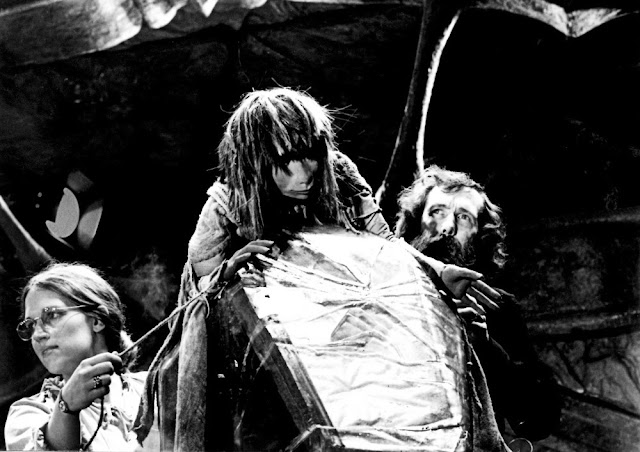The Dark Crystal is a 1982 dark fantasy film directed by Jim Henson and Frank Oz. It was marketed as a family film, but was notably darker than the creators’ previous material. The animatronics used in the film were considered groundbreaking for the time, with most creatures, like the Gelflings, requiring around four puppeteers to achieve full manipulation. The primary concept artist was fantasy illustrator Brian Froud, famous for his distinctive fairy and dwarf designs. Froud also collaborated with Henson on the 1986 fantasy film Labyrinth.
Jim Henson, famous for The Muppets, wanted The Dark Crystal to push the boundaries of what puppetry could achieve. He aimed to create a dark fantasy world that felt ancient and alive, without relying on human actors or traditional animation. Alongside co-director Frank Oz, Henson spent years developing the world of Thra, which was inspired by myths, folklore, and the works of conceptual artist Brian Froud.
Brian Froud was instrumental in shaping the film’s unique look. His illustrations formed the basis of the film’s creatures, environments, and characters. Froud’s designs were organic, surreal, and often unsettling, which perfectly suited the tone of the film. Froud worked closely with Jim Henson and the puppetry team to ensure his designs could be translated into practical puppets and sets.
The Dark Crystal was notable for being one of the first feature films with no human characters, relying entirely on puppets. The puppeteers, many of whom had worked with Henson on The Muppets, faced enormous challenges in bringing the complex characters to life. Each character was a sophisticated puppet. For example, the Skeksis, the film’s villainous race, were performed by multiple people: one puppeteer worked the head and hands while others controlled the eyes, facial expressions, and bodies. The lead character Jen, a Gelfling, was operated by a single puppeteer but required many advanced techniques for facial expressions and movement.
The puppets were incredibly detailed, with specially designed costumes and mechanical enhancements. The Gelflings, for instance, had a mixture of animatronic and puppetry features to create their expressive faces.
Each Skeksis puppet was a massive, intricate costume that weighed up to 80 pounds. These puppets had a complex internal system allowing for controlled movements of the facial features, particularly the eyes and beaks, which required collaboration between puppeteers.
The sets for The Dark Crystal were extraordinary in their detail and scale. Much of the film was shot on large, carefully constructed sound stages, featuring highly detailed environments that gave the world of Thra a lived-in feel.
The world of Thra was brought to life through a combination of hand-built sets, miniatures, and matte paintings. Special effects guru Roy Kinnear was essential in ensuring these elements blended together seamlessly.
Despite the reliance on puppetry, The Dark Crystal also utilized a variety of special effects, such as compositing and optical effects, to create the magical and otherworldly elements. For instance, the crystal itself, which plays a key role in the film, was a real glass prop that was manipulated to give it its glowing, ethereal qualities.
The Dark Crystal was released in 858 theaters in North America on December 17, 1982 and finished third for the weekend with a gross of $4,657,335, behind Tootsie and The Toy, performing better than some people expected. In its initial weekends, it had a limited appeal with some audiences for various reasons, including parental concerns about its dark nature when contrasted with Henson’s family-friendly Muppet franchise. In its third weekend, it moved up to second place nationally with a gross of $5,405,071 from 1,052 screens. It made $40,577,001 in its box office run, managing to turn a profit. The film became the 16th highest-grossing film of 1982 within North America. To date, it technically remains as one of the highest-grossing puppet animated films of all time, particularly for its domestic gross.






































0 comments:
Post a Comment